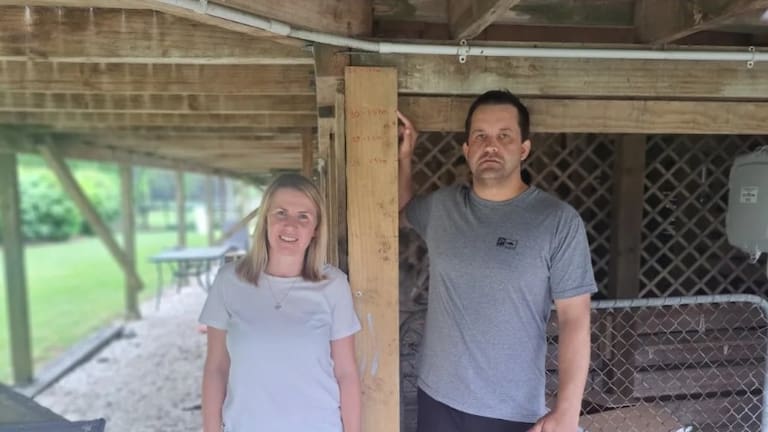It’s small, odourless and can turn waste into a resource in just four weeks. It’s called bokashi and — as Lucas de Jong finds out — a little bucket can make a big change.
"It's a way to ferment your food waste and retain all the nutrients, but it's to help rebuild your soil."
If you’ve seen a bokashi system at work, it’s likely Michelle Wilson’s “zing” is multiplying inside. The two-bucket system is delightfully simple: Food goes in, zing is sprinkled on top, and fermentation begins.
Zing looks like a bag of fine sawdust. But under the microscope, it’s a powerful combination of 70 good bacteria that come alive when a food source is introduced.

"Zing Bokashi was developed at Lincoln University in Christchurch by 'Mr. Bokashi', Neville Burch," said Wilson.
While worm farms will avoid citrus and onions, and compost heaps need the right balance of nitrogen and carbon, bokashi will take it all.
"You don't need to do any separation. It will take your citrus, onions, raw meat, cooked meat, chicken bones," Wilson explained.
When the bucket is full, you leave it out of the sun for seven to 10 days; keeping the lid on to limit oxygen to the anaerobic bacteria is essential.
Over that time, you have one small job: Collecting the liquid from the bottom bucket.
"We want to ensure we're draining it off every two to three days," said Wilson.

Any longer, and the bacteria in the "liquid gold" will start to die and smell, noted Wilson. But still fresh, it’s a probiotic tonic for your garden that will boost growth and plant health.
Dilute the liquid to the colour of a weak tea and then pour it on the soil.
Teaching bokashi
Phillippa Beagley from the Compost Collective travels around Auckland, teaching people about bokashi.
"It’s something that people have heard about but they're quite intrigued because they don't really know what it is because of a strange word," she said.
It’s a system that suits the inner city, those places with limited space, hence why it was developed in Japan.
"The beauty about bokashi is that the fermenting agent eats away at the odours, and it's a sealed system.
"There might be a vinegary pickled smell, but other than that, it's fine."

It’s a system accessible to anyone, especially with Beagley’s DIY bin design, which involves a couple of buckets and some heavy-handed drill work.
In fact, many councils and community groups subsidise Zing Bokashi.
At Kaipatiki’s Eco Hub, there’s a designated bokashi drop-off point. The local communities' food scraps are dropped here and added to the large compost piles.
"It's an amazing probiotic for the soil. It's more drought-resistant. It's holding onto more nutrients and feeding that to your plants. It's fantastic stuff."
Take a look at their screened compost, and the dark, rich hummus is teeming with life – it's nothing like the sterile bags you buy from the garden centres.
Big-scale bokashi
While the small and odourless size of bokashi bins is a big draw card for many, they’ve decided to go big at City to Farm, where they've been collecting food scraps for five years.
"We collect about a tonne and a tonne and a half of food scraps a week from the Hibiscus Coast businesses," said Betsy Kettle.
On a North Auckland farm, there's a platform with hundreds of old Auckland Council wheelie bins stacked up against each other that created a kaleidoscope of colour. Each bin has biochar and woodchip at the bottom.
They went with bokashi over traditional compost because fermenting food will remain odourless until you need it.

"The food scraps can last long enough to be collected once a week or every two weeks, so the bokashi is essential in what we're doing," said Kettle.
The term "food waste" is one that Kettle is quick to correct. She says it’s only wasted if it ends up in landfill. Instead, we need to think about it as a resource.
"If we feed the soil, we can feed the crops. Which in our case is bananas."
Banana bokashi
At the top of a nearby hill is a banana plantation brimming with giant bunches of lady-finger bananas.
They’ve only been fed fermented scraps spread across the soil surface and then covered with wood chips.
Five years ago, it was nothing but rock-hard clay. Now, if you dig around the bananas, you'll need to travel down at least 40cm to find anything that resembles clay.
"This used to be rock-hard clay. And now it just crumbles.
"What we think is happening is we're getting extremely rapid soil structure."
It’s a process that should take decades, but now this “unplantable land” is bearing fruit.
"If we could make a carbon sink and improve our soil and take care of, you know, basically drought-proof it. Why aren't we doing it?"
Using your bokashi
After 10 days out of the sun, your bokashi will be ready to use. The simplest way is to dig a small trench and bury it in the ground.

"It still looks like food waste. It’ll look exactly how you've put it in," said Wilson.
The difference is now microscopic bacteria are teaming all over it — bacteria that will spread through the soil in your garden and multiply.
"We tell people to put it where you're gonna use it."
Because after a few weeks, you can plant directly into the soil.
You're taking food and using it as fertiliser to grow more food — the perfect example of circular energy.


















SHARE ME